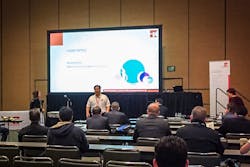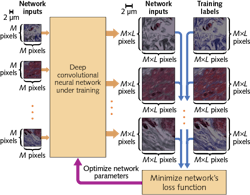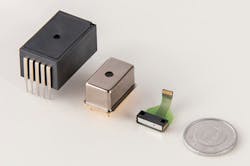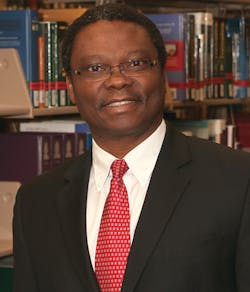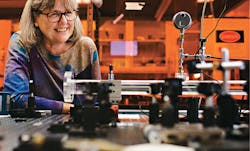Photonics West Conference Preview: SPIE Photonics West gets bigger (and better) in 2019
GAIL OVERTON, JOHN WALLACE, and BARBARA GEFVERT
“Photonics West will set new records again in 2019, firmly solidifying it as the world’s leading annual photonics exhibition and conference,” says SPIE senior director of Global Business Development Andrew Brown. “Filling the newly renovated Moscone Center in the heart of San Francisco, we will have the largest event to date, creating a world-class experience for our more than 23,000 attendees and 1350 exhibitors; in fact, the expanded exhibition floor space has already sold out.” Brown adds, “Photonics West sets the stage for the year ahead in the global photonics community and, based on demand, we can expect a very upbeat year.”
Brown says that not only will the 2019 event be the largest, but with a total of 5200 presentations representing nearly every aspect of the burgeoning photonics research and development ecosystem, it may be the best yet. “With an inspiring list of plenary and keynote speakers for each of the BIOS, OPTO, and LASE symposia, we are delighted to include recent Nobel laureate Donna Strickland in the program,” Brown says. He also notes that BiOS will once again feature the Saturday night Hot Topics session, with the associated BiOS exhibit, driving translational technologies and advances in healthcare, taking place on the first weekend.
SPIE Photonics West runs February 2-7, 2019. To support impactful photonics products and innovations, the conference will also host the SPIE Startup Challenge and the Prism Awards. And for those exploring career opportunities, the Job Fair will feature many of the industry’s leading companies in search of talented new employees. New this year, the industry hub on the show floor will create an “exciting focal point for the community,” according to Brown. It features 40 free events spanning five days, and is dedicated to advancing the business of photonics, including the highly popular two-day AR/VR/MR conference.
In addition to the exhibit and conference, SPIE Photonics West will offer more than 70 full- and half-day educational courses (for a fee, and providing continuing education units [CEUs]) and three free industry workshops, including workshop WS9012 on Wednesday, February 6 from 9-4:30 p.m. sponsored by Laser Components and entitled “How to Get the Most Out of Optics, Lasers, and Detectors” (see Fig. 1).
In the free WS9012 workshop, attendees can select one or more 30-minute sessions on three major topics: Optics, Lasers, and Detectors. The Optics presentations detail fundamentals of digital optics with spatial light modulators, insights into laser-induced damage threshold (LIDT) and high-power laser optics, custom laser optics coatings, and key parameters of polarizers. In the Lasers sessions, participants will review working principles of flash lidar, TIAs for photodiodes to maximize the range of lidar systems, how to drive FET-based pulsed laser hybrid circuits for optimized device performance, and benefits of laser-generated white light. And finally, the Detectors session describes working principles and comparison of different IR detectors and information on IR detector nonlinearity correction.
And don’t forget, for those with a particular interest in the laser industry, Laser Focus World will once again present its 2019 Lasers & Photonics Marketplace Seminar on February 4th at the Marriott Marquis, just adjacent to the Moscone convention center. The Seminar features keynote presentations from Ralf Kimmel of Trumpf and Matthijs Glastra of Novanta, along with interactive panels on precision optics and quantum technologies that are facilitating new innovations in photonics and driving laser sales.
LASE Symposium
Speaking of lasers, this year’s LASE Symposium features four conference tracks: Laser Sources (Conferences 10896-10901), Nonlinear Optics and Beam Guiding (10902-10904), Micro/Nano Applications (10905-10908), and Macro Applications (10909-10911).
With 810 total presentations, the LASE Symposium spans nearly all fields related to laser R&D and commercialization, including sources, laser-matter interactions, materials processing, and 3D printing.
Among the LASE highlights are the plenary presentations on Monday, February 4th, from 3:30-5:40 p.m. Earl H. Maize of NASA’s Jet Propulsion Laboratory will present “Cassini’s Grand Finale: Going Out in a Blaze of Glory,” describing the Cassini Program—from its beginning in 2004 exploring the Saturn system and concluding with a spectacular plunge into Saturn’s atmosphere in September 2017. He will present highlights from 13 years of exploration as well as the engineering and scientific rationale behind the mission’s final scenario and some of the complexities of an entirely new mission for an aging spacecraft. Yuji Sano of Japan Science and Technology Agency will present “Quarter Century Development of Laser Peening and Recent Strides toward Expansion of Applications,” discussing underwater laser ablation (laser peening) that generates high-pressure plasma exceeding the gigapascal level and will also discuss the recently developed femtosecond laser peening, which extends applications to integrated systems and components in space. And a third plenary by Günther Tränkle from Ferdinand Braun Institute describes, as its title states, “High Power Laser Diodes: Improvements in Power, Efficiency, and Brilliance.”
Among the four LASE conference tracks, the Laser Sources track alone includes 301 total papers, comprised of a plenary presentation, two keynotes, 41 invited presentations, 205 contributed papers, and 52 poster papers. In addition to these presentations, a panel discussion on the “Future Direction of High-Power Diode Laser Technology and Applications” is planned on Monday, February 4th from 8-9 a.m. in Conference 10900: High-Power Diode Laser Technology XVII.
Laser Sources track chairs Kunihiko Washio of Paradigm Laser Research and John Ballato of Clemson University said that conference submissions reveal a couple of noteworthy key technology trends—namely, a remarkable increase in power and brightness in a broad spectral range for lasers, including eye-safe and mid-infrared (mid-IR), as well as visible and the near-IR region, and many novel laser concepts and technologies that are emerging for solid-state, fiber, and diode lasers.
In addition to recommending attendance at the aforementioned plenary sessions and the keynote presentation on “Mid-IR VECSELs” from Marcel Rattunde of the Fraunhofer-Institut für Angewandte Festkörperphysik, Washio and Ballato wanted to highlight the following papers. Please note that if you enter the full title of the paper in the search bar at https://spie.org/conferences-and-exhibitions/photonics-west/lase, the date and time of the paper is listed below the link that takes you to the individual paper listing with paper number, authors, a link to the abstract, as well as a link that lets you add the paper to your schedule.
Among the invited LASE papers, the chairs recommend (1) “Compact, efficient Tm:YAP pumped mid-IR OPO”; (2) “High-power ultrafast Tm-doped fiber lasers for the generation of mid-infrared radiation in the molecular fingerprint region”; (3) “High-power, all-fiber-integrated super-continuum source from 1.57 to 12 microns”; (4) “Soliton Self-Mode Conversion (SSMC): Power-scalable frequency conversion with multimode fibers”; (5) “Recent development of the Orion Laser facility and future perspectives”; and (6) “Breath acetone analysis using a broadly-tunable mid-IR VECSEL”.
Washio and Ballato also recommend numerous papers on high-power blue lasers for materials processing applications, including (1) “500 Watt blue laser system for welding applications”; (2) “1000 W blue fiber-coupled diode-laser emitting at 450 nm” (see Fig. 2); (3) “High brightness fiber coupled diode lasers at 450 nm”; (4) “High-power and brightness 105-micron fiber coupled blue laser diode modules”; and (5) “Development of BLUE IMPACT, a 450nm-wavelength light source for laser processing.” In addition, they wanted to highlight “Light detection and ranging with a single free-running dual-comb semiconductor disk laser” from ETH Zurich.OPTO Symposium
Optics and photonics have a big role in shaping our future, a fact emphasized in the three OPTO plenary sessions, all held on Monday morning. Katharine Schmidtke, who is responsible for optical technology strategy at Facebook, gives a talk, “Hyperscale Data Center Applications of Optoelectronics,” in which she details the various uses of optoelectronics in the networks for hyperscale data centers that provide the base for our digital world. She discusses the next move for photonics, which is to handle distances of <3 m for in-rack applications. Next, Susumu Noda of Kyoto University presents “Two Decades of Progress for Photonic Crystals: From the Realization of Complete 3D Crystals to the State of the Art for Society 5.0,” in which he provides both an overview and the very latest technology on photonic crystals, including for lidar, materials processing, and thermal-emission shaping. Finally, Aydogan Ozcan of the California NanoSystems Institute and the University of California, Los Angeles (whom the Laser Focus World audience knows well from his research into field-portable smartphone microscopes) will delve into the use of deep learning for optical microscopy and microscopic image reconstruction, including the fabrication of a deep-learning neural network (see Fig. 3).OPTO conference program tracks this year include Optoelectronic Materials and Devices; Photonic Integration; Nanotechnologies in Photonics; MOEMS-MEMS in Photonics; Advanced Quantum and Optoelectronic Applications; Semiconductor Lasers, LEDs, and Applications; Displays and Holography; and Optical Communications: Devices to Systems.
Tuesday’s “Electrical-Optical PCB Technologies” session topic fits right in with Schmidtke’s Optoelectronics plenary talk. For example, a group from Shanghai Jiao Tong University gives the session’s invited paper on single-mode polymer waveguides and devices for high-speed on-board optical interconnect applications, while a team of Chinese and Finnish scientists presents on large-size directly inscribed polymer waveguide devices for card-to-card optical interconnect application (paper 10924-5); both these topics will aid tighter optical integration of the datacenter. In Tuesday’s “Hybrid Integrated Optical Link Modules” session, a group from integrated-optics giant LioniX discusses “Hybrid interconnection of InP [indium phosphide] and TriPleX [silicon nitride] photonic integrated circuits for new module functionality”; the InP-TriPleX combination are two complementary technologies the allows new functionalities—for example, the use of tunable ultranarrow-linewidth lasers for telecom and sensing applications.
The “Vertical-Cavity Surface-Emitting Lasers XXIII” session topic features the latest on this rapidly expanding laser technology. For example, Wednesday’s presentation, “Watt-class high-power and high-beam-quality VCSEL amplifiers” (paper 10938-8), by researchers from Fuji Xerox and the Tokyo Institute of Technology, covers single-mode continuous-wave (CW) millimeter-scale VCSEL structures useful for direct semiconductor laser processing and 3D sensing. “VCSELs in short-pulse operation for time-of-flight applications” (paper 10938-13), by a group from Philips Photonics, describes pulsed VCSEL modules as well as results from reliability experiments that indicate the limits of overpulsing, as well as the sweet spot for array design.
“Gallium Nitride Materials and Devices XIV” covers leading-edge short-wavelength semiconductor light sources such as optically pumped deep-UV lasers grown on native aluminum nitride (AlN) substrates (paper 10918-17), where a 193 nm excimer laser pumps an AlGaN structure, resulting in a laser peak at 278 nm with a 0.08 nm linewidth at room temperature. A team from Sandia National Labs and the University of New Mexico discusses “Nonpolar InGaN/GaN core-shell single nanowire lasers” (paper 10918-37), covering results showing optically pumped, room-temperature lasing from individual nonpolar p-i-n InGaN/GaN core-shell nanowires.
The “Advances in Display Technologies IX” session topic includes talks on augmented and virtual reality (AR/VR) displays—of which there are many experimentally realized varieties. A “Continuous-depth augmented-reality display device” (paper 10942-1) developed by researchers at Seoul National University is based on foveated retinal optimization, which enhances the central contrast by considering human visual characteristics. The “Augmented reality 3D display system based on holographic optical element” presentation (paper 10942-2) includes descriptions of two AR 3D display systems based on integral imaging using a microlens array of holographic optical elements (HOEs). The first is a dual-view-zone 3D display based on angle-multiplexing technology, while the second contains a compact lenticular lens-array HOE using divergent light as the reference beam. A team from CREOL, The College of Optics and Photonics, University of Central Florida discusses “Emerging high-dynamic-range mini-LED displays” (paper 10942-4), an analysis of the system configuration and performance of mini-LED backlit LCDs, including their advantages and remaining technical challenges.
AR/VR/MR Conference
The second annual AR/VR/MR (augmented, virtual, and mixed reality) Conference will be held Feb. 3-4 (Sunday and Monday; note that, although the conference is free, you must register. Speakers for 2019 include well-known names from both the commercial world and academia: Bernard Kress (Microsoft HoloLens), Jerry Carollo (Google), Ronald Azuma (Intel), Behnam Bastani (Oculus Facebook), Federico Capasso (Harvard), Hong Hua (University of Arizona), Jannick Rolland (University of Rochester), Robert Schultz (Vuzix), and many others.
An interactive panel session with some of the biggest names in VR, AR, and MR includes pioneers in smart glasses, cryptography and more: Jaron Lanier, a VR pioneer as well as a computer philosophy writer, computer scientist, visual artist, and composer of classical music; Mark Bolas, a VR pioneer who helped jumpstart the technology, now at Microsoft working on the “vision strategy” for Microsoft's Mixed Reality platform; Mary Lou Jepsen, a veteran technologist whose new startup is developing wearable diagnostics made from consumer electronic parts that cost as much as a smartphone; Ronald Azuma, innovator in AR, visualization, and mobile applications at HRL Labs, Nokia Research Center, and Intel Labs; Thad Starner, early smart glasses pioneer, and founder and director of the Contextual Computing Group at Georgia Tech’s College of Computing; and Jim Melzer (Thales Visionix), one of the pioneers for defense and military head mounted displays. Don’t forget to bring your questions to this panel session.
Courses at the AR/VR/MR Conference include Design Techniques and Applications; Optical Technologies and Architectures for VR, AR, and MR HMDs; Introduction to VR, AR, MR, and Smart Eyewear; Designing and Specifying Digital Cameras; HMD Requirements and Designs for AR; and others. Hands-on headset demos will be ongoing both Sunday and Monday.
In addition, the 2019 Optical Design Challenge will be held on Sunday; there, students from a variety of institutions will show off their leading-edge R&D aimed at improving any aspects of the optics in VR, AR, and MR. The day will include poster sessions, pitches, an award ceremony, and a reception.
BiOS Symposium
The Biomedical Optics Symposium (BiOS)—SPIE’s largest symposium at Photonics West—has been chaired for many years by two distinguished leaders in the field, James Fujimoto of MIT and R. Rox Anderson of the Wellman Center for Photomedicine, Massachusetts General Hospital and Harvard School of Medicine. While continuing in their capacity for the 2019 event, the duo is joined by another pair of respected researchers as BiOS’s first co-chairs: Jennifer Barton from the University of Arizona, and Wolfgang Drexler from the Medical University of Vienna, Austria. Barton and Drexler have in past years chaired the International Biomedical Optics Society (IBOS), and while the IBOS evening gathering will not take place in 2019, there are plenty of alternatives for attendees, starting with the BiOS Expo.
Featuring more than 200 exhibits, the expo will open February 2 (10 a.m. to 5 p.m. Saturday and Sunday). Expo goers can expect an array of product demonstrations and new-product debuts, including Hamamatsu’s SMD-series grating-based mini-spectrometers with micro-opto-electro-mechanical systems (MOEMS)-fabricated short-wave near-infrared (SWNIR) sensor heads (see Fig. 4), and Cyberdyne’s LED-based photoacoustic/ultrasound imaging system with functional, molecular and structural imaging capabilities.Even after a full day at the exhibits, so many attendees will flock to the BIOS Hot Topics Plenary on Saturday from 7-9 p.m. that few open seats will remain in the cavernous theater. The evening will begin with the presentation of the 2019 Biophotonics Technology Innovator Award to Stephen Boppart of the University of Illinois at Urbana-Champaign. The award honors Boppart’s achievement in computational optical coherence tomography (OCT) and its applications to basic and clinical sciences. Boppart’s work will be represented in three presentations at BiOS, one covering molecular histopathology with simultaneous label-free auto-fluorescence multi-harmonic (SLAM) microscopy, another on real-time multimodal multiphoton imaging for assessing tumor microenvironments intraoperatively, and a third discussing coherent control of opsins in living brain tissue.
Following that will be presentation of the SPIE-Franz Hillenkamp Postdoctoral Fellowship in Problem-Driven Biophotonics and Biomedical Optics. This award was launched in 2018, and the inaugural honoree was Haley Marks, a postdoctoral researcher at the Wellman Center for Photomedicine at Massachusetts General Hospital, working on a luminescent oxygen-sensing, drug-releasing SMART (for Sensing, Monitoring, And Release of Therapeutics) bandage that provides quantitative visual feedback for clinical treatment guidance. The 2019 winner will be announced at the event.
The final award presentation of the evening is the Britton Chance Biomedical Optics Award, which goes to Samuel Achilefu of Washington University School of Medicine in St. Louis for 2019 (see Fig. 5). This award is presented each year for outstanding lifetime contributions through development of innovative technologies that have facilitated advancements in biology or medicine. Achilefu is being honored for his work in optical and molecular imaging that enable cancer care and treatment. Following his award presentation, Achilefu will make the evening’s first technical presentation.Then, Sergio Fantini of Tufts University will facilitate the remaining presentations, starting with two on spectroscopy: Clare Elwell of University College London will discuss frontiers in near-IR spectroscopy, and Zhiwei Huang of National University of Singapore will explain spectroscopic cancer detection. Multispectral optoacoustic tomography is the topic that Daniel Razansky of University of Zurich and ETH Zurich will cover, and Eva Sevick of the University of Texas Houston will present a view on aging through the lens of translational biomedical optics. Another Washington University at St. Louis faculty member, Srikanth Singamaneni, will present a fluorescence enhancer called the plasmonic patch, and Alexander Vahrmeijer of Leiden University Medical Center will explain how targeted molecular imaging facilitates precision surgery. Finally, Chris Xu of Cornell University will report new advances in multiphoton imaging, and Yoshiaki Yasuno of University of Tsukuba will close out the evening by introducing the concept of extending OCT toward multiple-contrast imaging.
In a similar vein, the 2019 Neurotechnologies Plenary Session (part of the SPIE Brain Symposium) on Sunday, 3:30-5:30 p.m., will highlight advances in neurophotonics through talks by eight researchers. Subjects include Miniscope, a project for developing imaging technology via an open-source platform; 3D brain imaging in freely moving mice with multiphoton microscopy; the use of functional near-infrared spectroscopy (fNIRS) to objectively assess surgical skills; human brain interferometers to improve blood flow monitoring; and the creation of tools for the functional analysis of neural circuitry. An expert in imaging of cleared specimens, Raju Tomer of Columbia University will report the use of light sheet theta microscopy to quantitatively image large cleared samples. The plenary will conclude with a panel discussion moderated by Edmund Talley, a program director at the National Institute of Neurological Disorders and Stroke (NINDS).
A third plenary session on Sunday from 7:15-8 p.m. will feature Nobel laureate and former Optical Society (OSA) president Donna Strickland of the University of Waterloo (see Fig. 6). Strickland shared the 2018 Prize “for groundbreaking inventions in the field of laser physics.” One half of the prize went to Arthur Ashkin “for the optical tweezers and their application to biological systems” and the other half jointly to Strickland and Gérard Mourou “for their method of generating high-intensity, ultra-short optical pulses”—inventions that served to enable precision instrumentation for research, medicine, and other applications.Finally, at the Nano/Biophotonics Plenary (Tuesday 10:30-11:30 a.m.), Henry Hess of Columbia University will explain how “motor proteins” such as kinesin can serve as biological components in engineered nanosystems, and describe a proof-of-principle application: a “smart dust” biosensor for remote detection of biological and chemical agents.
Saturday’s Translational Research Lunchtime Forum (12:30-2 p.m.) will include presentations by selected participants from the Translational Research virtual symposium demonstrating innovative application of optical/light-based techniques that aim to improve outcomes for patients.
Monday’s SPIE Fellow Member Luncheon, while not a BiOS event, will focus on biomedical optics. Elizabeth Krupinski of Emory University will explain how artificial intelligence (AI) boosts the efficacy and efficiency of medical imaging, and important considerations for AI to enable success and improved patient care.
BiOS poster sessions will take place toward the end of each day Saturday (5:15-6:45 p.m.) through Monday (5:30-7 p.m.). Student presentations selected from these will participate in Monday’s (4:15-5:15 p.m.) 3-Minute Poster Presentation session sponsored by two journals, the Journal of Biomedical Optics and Neurophotonics. Judges will award cash prizes for the top three vote getters based on content and presentation effectiveness.
Another competition, the Startup Challenge, has awarded most of its prizes to biomedical optics entrepreneurs in past years. For 2019, the Startup Challenge will break out semi-finalist events by application area. The Biophotonics & Point of Care Semi-Finals (Tuesday 2-4 p.m.) will feature semi-finalists pitching their business concepts to judges who will determine which contestants will move on to the finals. Then on Wednesday (3:30-6 p.m.), the main event—the SPIE Startup Challenge Finals—will give the top two entrants from each semi-final track five minutes each to explain their photonics-based business vision to a panel of judges. The top presenter will go home with $10,000 in cash from JENOPTIK and $5000 of equipment from Edmund Optics.
BiOS 2019 will feature a baker’s dozen different Best Paper Awards to recognize, for instance, outstanding research in point-of-care diagnostics, or high-speed biomedical imaging and microscopy.
Finally, a popular FDA-focused annual session (Monday, 3:30-5:30 p.m.) will help academic investigators and entrepreneurs incorporate regulatory requirements into product development plans, produce successful regulatory strategies, understand review and regulatory approval for medical devices, and communicate effectively with FDA.
As in 2018, the BiOS conferences are organized into six tracks (Photonic Therapeutics and Diagnostics; Neurophotonics, Neurosurgery, and Optogenetics; Clinical Technologies and Systems; Tissue Optics, Laser-Tissue Interaction, and Tissue Engineering; Biomedical Spectroscopy, Microscopy, and Imaging; and Nano/Biophotonics). Plus, Photonics West features three new “application tracks,” (apparently virtual, meaning the presentations are coordinated in terms of theme, but not organized in time or space) two of which are bio-focused: SPIE Brain 2019 includes papers describing innovative technologies that promise to increase our understanding of brain function, and SPIE Translational Research 2019 highlights papers showcases technologies, tools, and techniques with potential for important impact on healthcare.
About the Author

Gail Overton
Senior Editor (2004-2020)
Gail has more than 30 years of engineering, marketing, product management, and editorial experience in the photonics and optical communications industry. Before joining the staff at Laser Focus World in 2004, she held many product management and product marketing roles in the fiber-optics industry, most notably at Hughes (El Segundo, CA), GTE Labs (Waltham, MA), Corning (Corning, NY), Photon Kinetics (Beaverton, OR), and Newport Corporation (Irvine, CA). During her marketing career, Gail published articles in WDM Solutions and Sensors magazine and traveled internationally to conduct product and sales training. Gail received her BS degree in physics, with an emphasis in optics, from San Diego State University in San Diego, CA in May 1986.
John Wallace
Senior Technical Editor (1998-2022)
John Wallace was with Laser Focus World for nearly 25 years, retiring in late June 2022. He obtained a bachelor's degree in mechanical engineering and physics at Rutgers University and a master's in optical engineering at the University of Rochester. Before becoming an editor, John worked as an engineer at RCA, Exxon, Eastman Kodak, and GCA Corporation.

Barbara Gefvert
Editor-in-Chief, BioOptics World (2008-2020)
Barbara G. Gefvert has been a science and technology editor and writer since 1987, and served as editor in chief on multiple publications, including Sensors magazine for nearly a decade.
